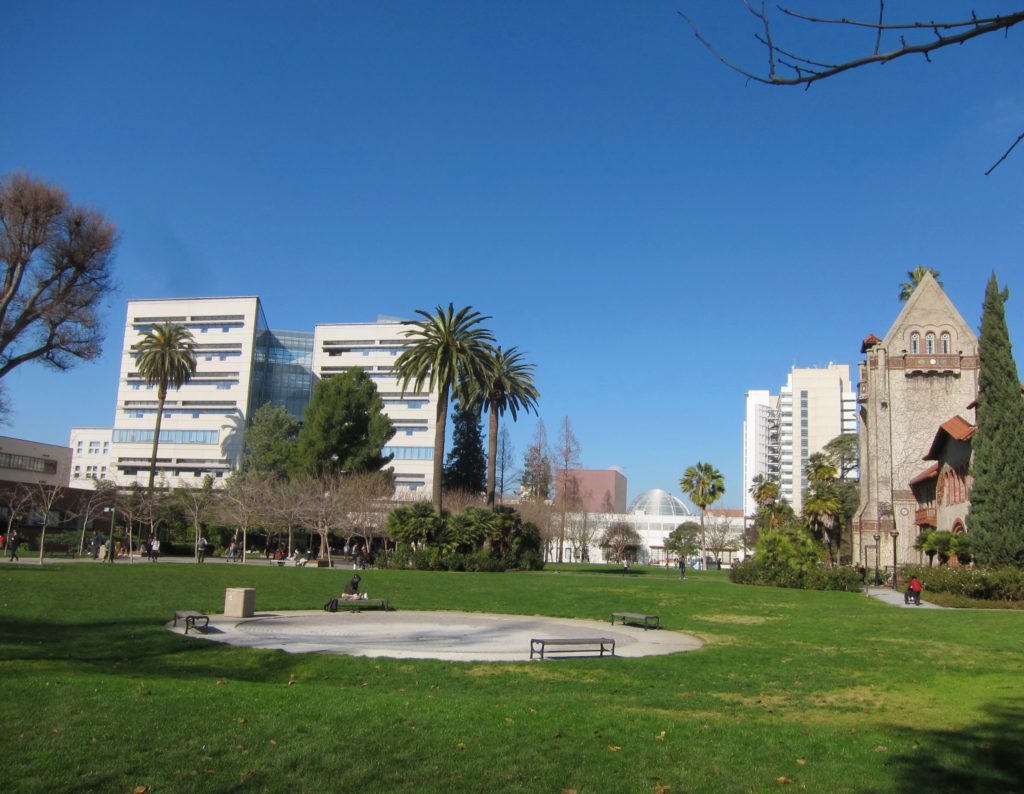
By Sharon Simonson
Not wildfires, mudslides, or monster commutes; not overcrowded and expensive housing, or gender-challenged workplaces. Nothing—so far—can keep them away: foreign students seeking U.S. college degrees and work experience have flocked to the Bay Area in recent years—more than to any other place in the country except New York City.
According to new research from the Pew Research Center based on more than a decade of student-visa data, the Silicon Valley and San Francisco metros rank among the top ten destinations for foreign students earning American university degrees and staying to work.
Including the more than 77,000 foreign students who migrated to the region for employment after earning degrees in other U.S. cities, the Bay Area attracted more than 120,000 foreign-student workers from 2004 to 2016—more than any other market in the country except New York City, Pew says.
![]() Silicon Valley’s particular magnetism for foreign-student graduates is the strongest in the country, said Neil Ruiz, an Oxford- and MIT-trained global human migration expert and the lead researcher for Pew. Of the 61 metro areas evaluated nationwide, the valley attracted the greatest share of foreign graduates from all others.
Silicon Valley’s particular magnetism for foreign-student graduates is the strongest in the country, said Neil Ruiz, an Oxford- and MIT-trained global human migration expert and the lead researcher for Pew. Of the 61 metro areas evaluated nationwide, the valley attracted the greatest share of foreign graduates from all others.
According to the data, the Silicon Valley workplace gains thousands of foreign-student graduates from the Los Angeles, New York-New Jersey, Pittsburgh, and Dallas-Ft. Worth metros. Los Angeles, for instance, sent 4,900 foreign graduates to Silicon Valley to work from 2004 to 2016. During the same time, Silicon Valley sent 600 foreign-student graduates to L.A.

The Optional Practical Training, or OPT, visa, which allows U.S.-educated foreign students with bachelor’s, master’s or doctoral degrees to work in the United States after graduating, is now the country’s largest and most important source of new temporary high-skilled immigrant workers, the Pew research shows. Its use has eclipsed the much better known H-1B visa: from 2004 to 2016, the federal government issued 1.474 million new OPT visas but only 1.473 million new H-1B visas.
The OPT visa allows graduates with STEM degrees—science, technology, engineering and mathematics—to work in the United States for as long as three years. Companies nationally including many in Silicon Valley and San Francisco are relying more than ever for their technical talent on the OPT, which has gained popularity since its potential term was extended from one year, first in 2008 by President George W. Bush to 29 months, and again in 2016 by President Barack Obama to 36 months.
The H-1B visa, the primary way that companies in the United States had hired high-skilled foreign workers, allows foreign people with advanced degrees from universities outside the United States to work in the country. But the number of new H-1B visas allowed each year is capped at 85,000. There is no cap on the number of OPT visas that can be issued.
The growth in OPT visas has been fueled by the growth in foreign students studying at U.S. colleges and universities. The number of F-1 academic student visas the federal government issues each year has more than doubled, rising from 179,000 issued in 2008 to 364,000 in 2016, Pew says.
American colleges and universities began increasing their foreign student enrollment after the 2008 Great Recession, Ruiz said.
Los Angeles’ University of Southern California enrolls and sends more foreign students into the American workplace than any other public or private higher-education institution: 27,100 in the twelve-year period that Pew studied. San Francisco-based Academy of Art University sent 6,800 foreign graduates into American workplaces, more than any other for-profit U.S. school. Of those, 5,100 stayed in the San Francisco-Oakland metro, making the Academy of Art second only to University of California, Berkeley, in terms of the number of its foreign graduates who stay in the San Francisco metro to work.
At San José State University, where domestic-student enrollment has been flat for the last decade, international enrollment has increased 65 percent. International students now constitute 10 percent of the student body, about 3,200 students in 2017, according to SJSU. SJSU is the largest source of foreign student graduate workers for Silicon Valley companies, sending 7,100 into the market from 2004 to 2016. Stanford University funneled 4,500 foreign student graduates into regional workplaces in the same time, USC, 3,000.![]()